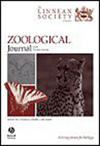Integrative systematics of the taxonomically complex gobiid genus Glossogobius Gill, 1859 (Teleostei: Gobiidae) from the south-western Indian Ocean, with a description of a new species
IF 2.8
2区 生物学
Q1 ZOOLOGY
引用次数: 0
Abstract
Glossogobius, a species-rich gobiid genus with 42 recognized species distributed in the Indo-West Pacific, lacks a comprehensive phylogenetic analysis. The highest diversity of the genus occurs in the tropical West Pacific, highlighting this region as a centre of endemism. In contrast, the Indian Ocean has lower diversity (nine species). This study offers the first thorough description of Glossogobius diversity in the south-western Indian Ocean through integrative analyses. Our findings reveal nine lineages, five of which are newly identified, including a new species, Glossogobius hanisii sp. nov., described from southern Africa and Madagascar. Seven species/lineages, along with G. kokius from Mauritius and G. tenuiformis, are endemic to the south-western Indian Ocean. With 65% of Indian Ocean Glossogobius species/lineages being endemic to the south-western region, it is identified as a hotspot of endemism. The genetic structuring of these lineages along the east coast of southern Africa appears to be shaped by an interplay between life history, oceanographic conditions, and adaptations to marine biogeographic regions. Additionally, our findings highlight Madagascar’s central role in Glossogobius diversification and evolution of unique gobies, provide a framework for a comprehensive revision of Glossogobius in the region, and facilitate the identification of conservation units and the formulation of management measures.印度洋西南部复杂虾蛄属(虾蛄目:虾蛄科)的综合系统分类及一新种描述
舌鱼属(Glossogobius)是分布在印度-西太平洋的一个种类丰富的虾蛄属,已知有42种,但缺乏全面的系统发育分析。该属的最高多样性发生在热带西太平洋,突出表明该地区是地方性的中心。相比之下,印度洋的多样性较低(只有9种)。本研究首次通过综合分析对西南印度洋舌鱼的多样性进行了全面描述。我们的发现揭示了9个谱系,其中5个是新发现的,包括一个新物种,来自非洲南部和马达加斯加的Glossogobius hanisii sp. nov.。7种/谱系,连同毛里求斯的G. kokius和G. tenuiformis,是西南印度洋特有的。由于65%的印度洋舌鱼物种/谱系是西南地区特有的,因此被确定为地区热点。沿着南部非洲东海岸的这些谱系的遗传结构似乎是由生命史、海洋学条件和对海洋生物地理区域的适应之间的相互作用形成的。此外,我们的研究结果突出了马达加斯加在Glossogobius多样化和独特虾虎鱼进化中的核心作用,为该地区Glossogobius的全面修订提供了框架,并为保护单元的确定和管理措施的制定提供了便利。
本文章由计算机程序翻译,如有差异,请以英文原文为准。
求助全文
约1分钟内获得全文
求助全文
来源期刊
CiteScore
6.50
自引率
10.70%
发文量
116
审稿时长
6-12 weeks
期刊介绍:
The Zoological Journal of the Linnean Society publishes papers on systematic and evolutionary zoology and comparative, functional and other studies where relevant to these areas. Studies of extinct as well as living animals are included. Reviews are also published; these may be invited by the Editorial Board, but uninvited reviews may also be considered. The Zoological Journal also has a wide circulation amongst zoologists and although narrowly specialized papers are not excluded, potential authors should bear that readership in mind.

 求助内容:
求助内容: 应助结果提醒方式:
应助结果提醒方式:


